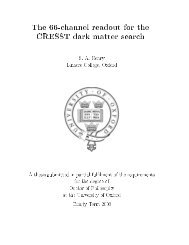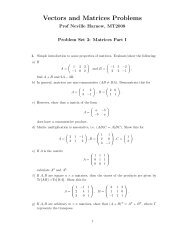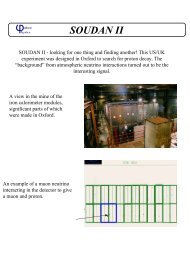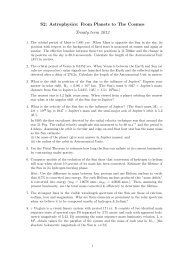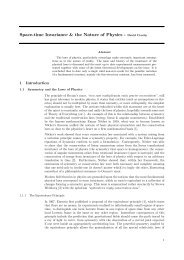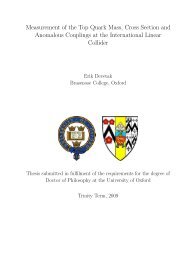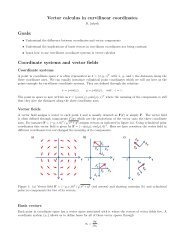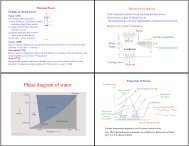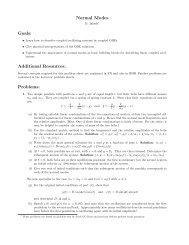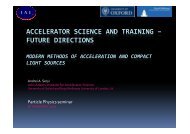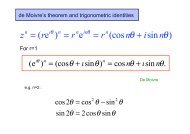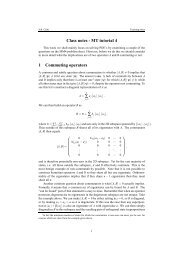ATOMIC AND LASER PHYSICS - Department of Physics
ATOMIC AND LASER PHYSICS - Department of Physics
ATOMIC AND LASER PHYSICS - Department of Physics
You also want an ePaper? Increase the reach of your titles
YUMPU automatically turns print PDFs into web optimized ePapers that Google loves.
<strong>ATOMIC</strong> <strong>AND</strong> <strong>LASER</strong> <strong>PHYSICS</strong><br />
Pr<strong>of</strong>essor Ian Walmsley<br />
Research in the department involves some <strong>of</strong> the most rapidly developing areas <strong>of</strong> physical<br />
science. In the centre for quantum computation the challenge to develop the dramatic promise<br />
<strong>of</strong> quantum systems for information processing has been taken up. The properties <strong>of</strong> Bose-<br />
Einstein condensed atomic assemblies and their potential for atom optics and interferometry<br />
are studied. Novel atom and ion traps are used to probe the properties <strong>of</strong> species newly<br />
accessible in the laboratory. High power and short pulse lasers are used to probe and modify<br />
atomic and plasma processes and to investigate non-linear optical phenomena. The development<br />
<strong>of</strong> new lasers with a wide variety <strong>of</strong> scientific and technical applications is actively<br />
pursued. This includes the drive at the Oxford Institute for Laser Science to link these latest<br />
developments to a wider scientific community. Theoretical studies <strong>of</strong> the microscopic physics<br />
behind the system study are a crucial part <strong>of</strong> the department’s research and interweave with the<br />
experimental programmes in many areas.<br />
1 The Centre for Quantum Computation<br />
The discovery that quantum physics allows fundamentally new modes <strong>of</strong> information processing<br />
has required the existing theories <strong>of</strong> computation, information and cryptography to be<br />
superseded by their quantum generalisations. The Centre for Quantum Computation conducts<br />
theoretical and experimental research into all aspects <strong>of</strong> quantum information processing, and<br />
into the implications <strong>of</strong> the quantum theory <strong>of</strong> computation for physics itself.<br />
Theory Group<br />
D Deutsch, V Vedral, A Steane, S Bose<br />
The theory group concentrates on the physics <strong>of</strong> information. It studies the nature <strong>of</strong><br />
information encoded in quantum states, and its relevance to new forms <strong>of</strong> cryptography which<br />
can guarantee perfectly secure communication. We have pioneered this field and are still<br />
involved in studying various aspects <strong>of</strong> security in quantum data processing devices. We also<br />
analyse quantum phenomena such as quantum entanglement and interference in the context <strong>of</strong><br />
new modes <strong>of</strong> computation. The extra power <strong>of</strong> quantum computers arises from the ability <strong>of</strong><br />
a quantum system to follow many distinct computational paths simultaneously and produce a<br />
final output depending on the interference <strong>of</strong> all <strong>of</strong> them. The group studies how, in principle,<br />
the possibility <strong>of</strong> such interference makes the theory <strong>of</strong> quantum computation differ from its<br />
somewhat better understood classical counterpart. The research covers areas such as the<br />
computational complexity <strong>of</strong> quantum algorithms, quantum logic gates and their networks,<br />
quantum communication complexity, and various methods <strong>of</strong> stabilising quantum computation.<br />
The group also investigates the practicalities <strong>of</strong> quantum computation and possible spin-<strong>of</strong>fs,<br />
such as, for example, better frequency-standard devices.<br />
We are also interested in entanglement quantification and how it can be used to investigate<br />
fundamental problems in physics. Thermodynamics and information theory have had a long<br />
and productive relationship, culminating in the work <strong>of</strong> Jaynes and in Landauer’s principle, that
30<br />
O X F O R D P H Y S I C S R E S E A R C H<br />
any erasure <strong>of</strong> information involves a corresponding increase in entropy. A similar approach<br />
can be used to investigate the relationship between quantum thermodynamics and quantum<br />
information theory.<br />
We also investigate how much entanglement is present naturally between constituents <strong>of</strong><br />
complex systems (such as spin chains) and how these vary with temperature and externals<br />
fields. We study the role <strong>of</strong> indistinguishability and particle statistics in quantum information<br />
processing. For example, entangling identical particles using statistics- induced effective<br />
forces.<br />
Coherent Matter Wave Group<br />
K Burnett<br />
The atomic physics group is engaged in the study <strong>of</strong> Bose-Einstein condensed atomic gases.<br />
Part <strong>of</strong> this work overlaps with the study <strong>of</strong> how many-particle systems may be used as<br />
computational devices. The possibilities for doing this relate to the way information is<br />
effectively processed by atoms as they interact and develop entangled many-particle states.<br />
The manner in which such entanglement is influenced by incoherent decay processes lies at the<br />
heart <strong>of</strong> the issues the group is addressing. Bose-Einstein condensates contain a macroscopic<br />
number <strong>of</strong> particles in a single quantum state, and the extent to which this can be exploited is an<br />
open issue. The group will be studying, in concert with the other groups, the advantages or<br />
otherwise <strong>of</strong> these systems as information processors including the use <strong>of</strong> atomic condensed<br />
gas arrays in optical lattices.<br />
It is very likely that these studies <strong>of</strong> multi-particle entanglement will also give important<br />
insights into the nature <strong>of</strong> the condensation process. This is being studied e.g. as a way to<br />
produce the optimally coherent source <strong>of</strong> matter waves. This will provide a strong basis for<br />
continuing exchange between the two areas.<br />
Experimental Quantum Communication and Cryptography Group<br />
D Bouwmeester, J Rarity<br />
In the last five to ten years many elegant and surprising new theoretical ideas have been put<br />
forward in relation to quantum computation and quantum communication. Experiments with<br />
photons have been successful in demonstrating quantum teleportation, entanglement swapping,<br />
quantum cryptography and generating <strong>of</strong> Greenberger-Horne-Zeilinger entanglement. We<br />
will continue such quantum optical experiments in close collaboration with the theory groups.<br />
Our aims include the implementation <strong>of</strong> novel quantum cryptography schemes, studying new<br />
sources <strong>of</strong> entangled photons, and realising decoherence-suppressing schemes. Recent theoretical<br />
ideas such as quantum error correction and entanglement purification have been introduced<br />
to overcome the problem <strong>of</strong> decoherence in real systems and it will be interesting and important<br />
to implement these schemes using quantum optical devices.<br />
Experimental Ion Trap Quantum Computation Group<br />
A Steane, D Stacey
<strong>ATOMIC</strong> <strong>AND</strong> <strong>LASER</strong> <strong>PHYSICS</strong><br />
31<br />
Experimental methods in atomic physics and quantum optics are currently among the most<br />
precise available in physics or any other science. It is now possible to manipulate and measure<br />
single atoms, or small groups <strong>of</strong> atoms, by first confining them by electromagnetic potentials —<br />
making a so-called atom or ion ‘trap’— and then illuminating them with pulses <strong>of</strong> laser light <strong>of</strong><br />
controlled frequency and duration. The importance <strong>of</strong> the ion trap for quantum information<br />
processing is that it is the only method which allows complete control <strong>of</strong> an isolated severalqubit<br />
quantum system using current technology. Individual ions can be probed and re-set at<br />
will, which allows active stabilisation <strong>of</strong> the system by probing for errors and correcting them.<br />
We have recently built and are currently running such a device. The major research aims are to<br />
demonstrate new methods which we have proposed to probe the quantum states, and to<br />
achieve quantum processing among the ions, especially quantum error correction. We aim to<br />
study open questions in the fundamental theory <strong>of</strong> quantum computing, going beyond basic<br />
demonstration experiments.<br />
Experimental Nuclear Magnetic Resonance (NMR) Quantum<br />
Computation Group<br />
J A Jones<br />
Liquid state NMR is currently the leading technology for implementing small quantum<br />
computers. We exploit the nuclear spins in a small molecule to represent quantum information,<br />
and the NMR information processor uses a large ensemble <strong>of</strong> such ‘computers’ in solution. In<br />
1997 we demonstrated the first experimental implementation <strong>of</strong> a quantum computer by<br />
implementing Deutsch’s algorithm on a two qubit NMR quantum computer. Since that time a<br />
variety <strong>of</strong> other algorithms and quantum phenomena, such as quantum teleportation, have been<br />
demonstrated. We are currently investigating the implementation <strong>of</strong> larger ensemble quantum<br />
computers and the implementation <strong>of</strong> more complex algorithms and procedures using NMR<br />
techniques. The group also studies the general nature <strong>of</strong> ensemble quantum computation and its<br />
relationship to more ‘conventional’ models. Theoretical aspects <strong>of</strong> this programme are carried<br />
out at the Centre in conjunction with the theory group.<br />
Novel Solid State Computation Group<br />
N F Johnson, S C Benjamin<br />
This theoretical group explores quantum phenomena in solid-state nanostructures with a view<br />
to improving classical computation and implementing quantum information processing. As the<br />
scale <strong>of</strong> solid state devices is reduced, quantum effects such as tunnelling, state superposition<br />
and entanglement arise; we seek ways <strong>of</strong> exploiting these effects rather than merely tolerating<br />
them. It should prove possible to dramatically enhance the power <strong>of</strong> classical information<br />
processing, and it may even be possible to realise a true quantum information processor. There<br />
are a number theoretical objectives being addressed within the group, which should maximise<br />
the chances <strong>of</strong> fully harnessing solid-state quantum phenomena for computation. Research<br />
ranges from the study <strong>of</strong> the dynamics <strong>of</strong> ‘quantum dots’ and other existing nano-scale<br />
structures, through to the search for the overall ‘model’ <strong>of</strong> quantum computation which is best<br />
suited to the physics <strong>of</strong> solid state systems.
32<br />
O X F O R D P H Y S I C S R E S E A R C H<br />
2 The Oxford Institute for Laser Science<br />
P Ewart, C E Webb, D W Coutts<br />
The Oxford Institute for Laser Science based in the <strong>Physics</strong> <strong>Department</strong> is a centre <strong>of</strong><br />
interdisciplinary research in lasers and their applications. At the heart <strong>of</strong> the Institute lie the<br />
research groups <strong>of</strong> Ewart, Webb and Coutts whose research programs are outlined in the<br />
paragraphs below. The Oxford Institute for Laser Science seeks to stimulate truly interdisciplinary<br />
activity based on the potential <strong>of</strong> lasers to open up and to explore new areas <strong>of</strong> research.<br />
In addition to engaging in co-operative and collaborative research with researchers in other<br />
departments in Oxford, the Institute can also provide a centre for technical support for those<br />
departments that lack expertise in laser technology. The Institute has a diverse range <strong>of</strong> research<br />
programs funded through the research councils and under contract for industry.<br />
Theoretical non-linear optics<br />
P Ewart<br />
Non-linear optics describes the interaction <strong>of</strong> laser light with matter. The intense electric fields<br />
in laser light modify the atomic or molecular behaviour leading to effects <strong>of</strong> interest in both<br />
fundamental physics and applications. We study in particular the basic physics <strong>of</strong> third order<br />
non-linear optical processes in which an atom or molecule is subjected to three separate laser<br />
fields leading to the generation <strong>of</strong> a fourth laser-like beam – four-wave mixing, FWM.<br />
Our fundamental studies have revealed subtle quantum interference effects arising from the<br />
interplay <strong>of</strong> random fluctuations <strong>of</strong> the incident fields and atomic relaxation. This work helps us<br />
understand the complex effects <strong>of</strong> laser modes and field statistics in non-linear spectroscopy.<br />
We have also developed the theory <strong>of</strong> degenerate four-wave mixing, DFWM to overcome the<br />
limitations inherent in the usual perturbation theory approach. This work allows quantitative<br />
simulations <strong>of</strong> DFWM spectra <strong>of</strong> complex molecules used in chemical physics applications.<br />
Non-linear laser spectroscopy<br />
P Ewart<br />
We develop novel non-intrusive and remote sensing techniques for molecular spectroscopy and<br />
chemical physics applications. Molecular spectra can be recorded using DFWM with frequency-scanned<br />
narrow line-width lasers yielding high resolution spectra from which accurate<br />
molecular parameters may be deduced. Alternatively, a spectrum, with lower resolution, may<br />
be recorded using a single shot from a broadband laser. The analysis <strong>of</strong> spectra recorded using<br />
these techniques is based on the theoretical models <strong>of</strong> DFWM developed in the group.<br />
The methods <strong>of</strong> non-linear spectroscopy using DFWM, polarization spectroscopy and cavity<br />
ring-down spectroscopy are being extended to the mid-infra red spectral region for the detection<br />
<strong>of</strong> hydro-carbon species important in combustion, plasma and atmospheric chemistry.
<strong>ATOMIC</strong> <strong>AND</strong> <strong>LASER</strong> <strong>PHYSICS</strong><br />
33<br />
Combustion diagnostics<br />
P Ewart<br />
The application <strong>of</strong> DFWM to detection <strong>of</strong> trace molecular species in combustion processes<br />
was pioneered by the group. Using variations <strong>of</strong> the DFWM process we have developed<br />
methods to measure trace concentrations <strong>of</strong> radical or molecular species, temperature and<br />
pressure in flames and engines. Current activity is directed to making multi-parameter and<br />
multi-dimensional measurements with time and space resolution. A major aim <strong>of</strong> the present<br />
work is to extend high-resolution non-linear techniques to the spectroscopically rich infra-red<br />
region where many important hydrocarbon molecules have their ‘finger-print’ spectra. This<br />
work is underpinned by our theoretical modelling to permit quantitative analysis <strong>of</strong> the data<br />
obtained and is complemented by our activity in developing novel laser systems employed in<br />
these techniques.<br />
A variation on DFWM is Laser Induced Thermal Grating Spectroscopy, LITGS, which we have<br />
developed for applications in high pressure combustion. We are developing new laser sources to<br />
improve the sensitivity <strong>of</strong> the technique and aim to apply it to engines in the near future for<br />
trace species detection and simultaneous temperature and pressure measurement.<br />
We have used LITGS as the basis <strong>of</strong> a new method to measure the velocity <strong>of</strong> high speed gas<br />
flows which we call Thermal Grating Velocimetry, TGV. Existing methods <strong>of</strong> gas velocimetry<br />
require seeding <strong>of</strong> the flow with particles. Our TGV technique does not require such seeding and<br />
so is particularly suitable for very high speed flows.<br />
The group is involved in collaborative research programmes in combustion diagnostics with<br />
two major centres in Germany: the Institute for Technical Combustion, University <strong>of</strong> Stuttgart<br />
and the Physical Chemistry Institute, University <strong>of</strong> Bielefeld.<br />
Novel laser development<br />
P Ewart<br />
The modeless laser, invented in the group, is now widely applied in broadband spectroscopic<br />
techniques using CARS, DFWM and polarization spectroscopy, PS. High power versions<br />
using dye amplification media are developed for such applications. New solid state materials<br />
are being studied to allow broadband modeless operation in the UV for diagnostic applications<br />
based on the OH radical.<br />
We are developing a high-power single-mode tunable laser source. The system uses the<br />
modeless laser to amplify the output <strong>of</strong> tuneable single-mode diode lasers to give pulses <strong>of</strong> high<br />
peak power (>10 5 W) and Fourier transform limited bandwidths (~160 MHz). Difference<br />
frequency generation is used to convert the high spectral brightness output to the infra-red for<br />
non-linear spectroscopy <strong>of</strong> radicals and molecules.<br />
Engineering and biological applications <strong>of</strong> lasers<br />
P Ewart<br />
In collaboration with the group <strong>of</strong> Dr Richard Stone in the <strong>Department</strong> <strong>of</strong> Engineering Science<br />
we have established a centre for optical diagnostics <strong>of</strong> internal combustion engines. Using four-
34<br />
O X F O R D P H Y S I C S R E S E A R C H<br />
wave mixing techniques including coherent anti-Stokes Raman scattering, CARS and DFWM<br />
we have made measurements <strong>of</strong> gas temperature and polluting gas formation in the cylinder <strong>of</strong><br />
a firing spark-ignition engine. These measurements are used to validate models <strong>of</strong> combustion<br />
and engine performance with the aim <strong>of</strong> improving fuel-efficiency and reducing pollution.<br />
We are developing collaboration with Dr Derek Terrar in the <strong>Department</strong> <strong>of</strong> Pharmacology in<br />
Oxford to study laser induced fluorescence <strong>of</strong> Ca + ions in biological systems. This work aims to<br />
study the dynamics <strong>of</strong> muscle contraction by using fibre-optic delivery systems and fluorescence<br />
microscopy to trigger specific sites within individual muscle cells. The technique is used<br />
to study effects <strong>of</strong> drugs on spontaneous and induced triggers <strong>of</strong> particular relevance to heart<br />
disorders.<br />
Metal vapour lasers<br />
C E Webb, D W Coutts<br />
Efficient and very high power lasers employing vapours <strong>of</strong> metallic elements such as copper<br />
and gold have been developed as practical devices and have found many practical applications.<br />
Copper lasers (operating in the green and yellow) based on designs originated by the group are<br />
used for high speed photography, laser micromachining and fibre Bragg grating production<br />
(using frequency doubled output in the UV). They also provide the primary pump radiation for<br />
tunable dye lasers used in medicine as well as spectroscopy and fundamental research in many<br />
branches <strong>of</strong> atomic physics and chemistry. In collaborative projects with other departments,<br />
these lasers are being used to gain information on particle sizes and velocities in plasma torches<br />
for ceramic coating applications, and for the determination <strong>of</strong> the age <strong>of</strong> rocks using oxygen<br />
isotope ratio techniques. Techniques for dramatically improving the performance <strong>of</strong> copper<br />
vapour lasers by use <strong>of</strong> kinetic-enhancing gas additives are being explored.<br />
New types <strong>of</strong> gold vapour laser are being investigated because the combination <strong>of</strong> red (628 nm)<br />
and ultra violet (312 nm) output wavelengths is very suitable for micro machining applications<br />
in both metals and plastics. Technological problems with the plasma tube construction<br />
previously prevented the gold laser from realising its potential. However, recent research<br />
suggests that more practical designs may be possible. The same kinetic enhancement techniques<br />
used for copper vapour lasers may also be applied to produce a new generation <strong>of</strong> efficient gold<br />
vapour lasers.<br />
Atmospheric monitoring<br />
C E Webb, D W Coutts<br />
A project under the EU Framework programme ‘Environment’ centres on a collaboration with<br />
a group at the KFA laboratory in Jülich, Germany, to develop a mobile instrument which can<br />
detect and measure concentrations <strong>of</strong> the free radical OH in the atmosphere. This molecular<br />
species is an important indicator <strong>of</strong> the ‘health’ <strong>of</strong> the atmosphere and is relevant to attempts<br />
to monitor the effects <strong>of</strong> pollution. The instrument employs a tunable laser source operating in<br />
the region <strong>of</strong> 308 nm pumped by a copper vapour laser capable <strong>of</strong> very high (10 kHz) pulse<br />
repetition rate. A prototype based on a frequency-doubled dye laser pumped by a copper<br />
vapour laser has been tested very successfully in field trials in Germany. Efforts have been<br />
directed towards developing compact, mobile units capable <strong>of</strong> airborne operation for example in<br />
a survey ship or aircraft available to participants in the Environment project.
<strong>ATOMIC</strong> <strong>AND</strong> <strong>LASER</strong> <strong>PHYSICS</strong><br />
35<br />
Solid-state UV lasers<br />
D W Coutts<br />
Cerium 3+ -doped fluoride crystal lasers operating in the 280 – 340 nm UV spectral region<br />
pumped by KrF excimer and frequency-quadrupled Nd:YAG lasers have been demonstrated<br />
recently. The group has pioneered the application <strong>of</strong> frequency-doubled copper vapour lasers<br />
as alternative pump sources operating at significantly higher pulse repetition rates (up to 10<br />
kHz rather than 0.10 – 10 Hz). Applications include ultra-short UV pulse amplification and use<br />
as a solid-state alternative to frequency doubled dye lasers for 308 nm generation for atmospheric<br />
OH detection.<br />
UV lasers operating in the 235-255 nm range are required for writing fibre Bragg gratings –<br />
essential components in modern high capacity fibre optic communications networks and in<br />
fibre sensors. We are actively investigating all-solid-state alternatives to the frequency-doubled<br />
copper vapour, frequency-doubled argon ion and KrF excimer gas lasers presently used for this<br />
application.<br />
Laser micromachining<br />
C E Webb, D W Coutts<br />
The group has recently participated in a large international collaboration under the Brite-Euram<br />
project funded by the EU. In collaboration with Oxford Lasers Ltd, a company ‘spun <strong>of</strong>f’ from<br />
the group in 1977, metal vapour lasers are used to perform intricate cutting and drilling <strong>of</strong> metals<br />
and ceramics, at the level <strong>of</strong> 10 micron feature size and smaller. Periodic sub-micron structuring<br />
<strong>of</strong> polished metal surfaces is being investigated in collaboration with industrial partners.<br />
Details <strong>of</strong> the interaction <strong>of</strong> the laser beam with the target material are the subject <strong>of</strong> theoretical<br />
and experimental studies. Of particular interest is experimentally and theoretically investigating<br />
the relative merits <strong>of</strong> nanosecond pulse vs femtosecond pulse micromachining in an industrial<br />
context.<br />
3 Short- wavelength lasers and laser-driven particle<br />
accelerators<br />
S M Hooker<br />
Recent advances in femtosecond lasers have made routine the generation <strong>of</strong> optical pulses<br />
containing terawatts <strong>of</strong> power with peak intensities <strong>of</strong> 10 16 - 10 18 W cm -2 , raising the possibility<br />
<strong>of</strong> new types <strong>of</strong> small-scale short-wavelength lasers and miniature particle accelerators.<br />
Novel short-wavelength lasers may be driven by a process known as ‘optical field ionization’.<br />
This occurs for intensities greater than approximately 10 16 W cm -2 , when the electric field<br />
associated with an electromagnetic wave is greater than that which binds the valence electrons<br />
<strong>of</strong> an atom. The threshold nature <strong>of</strong> this ionization process enables considerable control over<br />
the ion species generated, through the laser intensity, and by adjusting the polarization <strong>of</strong> the<br />
driving radiation the final energy <strong>of</strong> the ionized electrons may also be varied. The plasmas<br />
formed by this method are very promising media for creating population inversions at short<br />
wavelengths via either collisional excitation or electron-ion recombination. Several lasers in the
36<br />
O X F O R D P H Y S I C S R E S E A R C H<br />
extreme ultraviolet and s<strong>of</strong>t X-ray spectral regions have recently been demonstrated with this<br />
approach.<br />
Small-scale particle accelerators may also be driven by intense laser pulses. When an intense<br />
laser pulse propagates through a plasma, electrons are pushed away from the front and back <strong>of</strong><br />
the pulse leading to the formation <strong>of</strong> a longitudinal plasma wave that propagates at the group<br />
velocity <strong>of</strong> the optical pulse. The longitudinal electric field in the plasma wave can be as high as<br />
100 GeV m -1 , more than three orders <strong>of</strong> magnitude larger than that found in conventional RF<br />
accelerators such as those used at CERN. Particles injected into the correct phase <strong>of</strong> the plasma<br />
wave can be accelerated to energies <strong>of</strong> order 1 GeV in only a few tens <strong>of</strong> millimetres (the rest<br />
mass <strong>of</strong> the electron is ~ 0.5 MeV). This ‘laser wakefield accelerator’ is particularly promising<br />
for generating beams <strong>of</strong> short pulse, high-energy electrons for applications in femtosecond<br />
electron diffraction, medical imaging, and miniature free-electron X-ray lasers.<br />
Both short-wavelength lasers and laser wakefield acceleration require laser pulses with intensities<br />
<strong>of</strong> order 10 16 - 10 18 W cm -2 to propagate tens <strong>of</strong> millimetres through moderately dense plasmas.<br />
However, the laser-plasma interaction length is fundamentally limited by diffraction to distances<br />
<strong>of</strong> order the Rayleigh range, which for spot sizes <strong>of</strong> a few tens <strong>of</strong> microns is only a few<br />
millimetres. Refractive de-focusing <strong>of</strong>ten restricts the interaction length still further.<br />
We have recently developed a new type <strong>of</strong> waveguide which is able to overcome such defocusing.<br />
The ‘gas-filled capillary discharge waveguide’ operates by running a simple pulsed<br />
discharge in a gas contained by a narrow-bore capillary. Within the plasma which is formed,<br />
radial heat conduction to the walls <strong>of</strong> the capillary causes the temperature to be greater, and<br />
hence the density to be lower, along the axis <strong>of</strong> the capillary than at the capillary walls. Since the<br />
refractive index <strong>of</strong> a plasma decreases as the electron density increases, this radial electron<br />
density pr<strong>of</strong>ile acts as a positive lens which continuously re-focuses a propagating optical<br />
pulse. In recent experiments we were able to demonstrate guiding <strong>of</strong> laser pulses with a peak<br />
intensity <strong>of</strong> 10 17 W cm -2 over lengths <strong>of</strong> 30- and 50 mm with a pulse energy transmission <strong>of</strong><br />
90% and 80% respectively, corresponding to the lowest losses yet reported for channelling<br />
laser pulses <strong>of</strong> such high-intensity.<br />
The gas-filled capillary discharge waveguide is being further developed in order to allow<br />
channelling over longer plasma lengths, as well as tailoring the properties <strong>of</strong> the plasma channel<br />
to the particular requirements <strong>of</strong> short-wavelength lasers and laser driven accelerators. A<br />
number <strong>of</strong> experiments to drive short-wavelength lasers within the guiding channel <strong>of</strong> the<br />
waveguide will be undertaken in the near future. Recently we were awarded significant funding<br />
under the UK Research Councils’ Basic Technology programme to investigate electron acceleration<br />
within the waveguide, and the prospects <strong>of</strong> using the output electron beam to drive novel<br />
X-ray free-electron lasers.<br />
4 Theory <strong>of</strong> atomic and electron interactions in laser<br />
fields<br />
K Burnett<br />
Atoms, ions and electrons in ultra-intense fields<br />
Recent developments in the amplification <strong>of</strong> sub-picosecond pulses have led to tabletop laser
<strong>ATOMIC</strong> <strong>AND</strong> <strong>LASER</strong> <strong>PHYSICS</strong><br />
37<br />
systems that can generate powers around ten terawatts. Within the next year these lasers will<br />
reach the petawatt (10 15 W) level. When focused these sources produce intensities close to 10 23<br />
Wcm -2 , and electric field strengths hundreds <strong>of</strong> times larger than an atomic field strength.<br />
We are studying the interaction <strong>of</strong> such ultra-intense pulses with atoms, plasmas and clusters.<br />
We are developing new theoretical methods to treat electron correlation effects in intense laser<br />
fields. This work is aimed towards the development <strong>of</strong> new coherent sources <strong>of</strong> X-rays. Of<br />
particular interest at the moment is the way intense field processes occur in rare-gas clusters.<br />
This is a field in which rapid developments are occurring and we are providing theoretical<br />
modelling and advice for several experimental groups at Oxford and Imperial College, London.<br />
Bose condensation and atom lasers<br />
It has recently proved possible to produce Bose condensed assemblies <strong>of</strong> trapped atoms. These<br />
ultracold µK – nK objects have fascinating properties that we are just beginning to explore. Part<br />
<strong>of</strong> this work involves the study <strong>of</strong> how these macroscopic quantum objects respond to external<br />
electromagnetic probes. These studies are closely linked to the experimental work at Oxford<br />
and elsewhere. The other main subject <strong>of</strong> our research in this area is the study <strong>of</strong> ‘atom-lasers’<br />
and non-linear atom optics. This could also be termed coherent matter wave physics. In this<br />
we are constructing theories <strong>of</strong> matter wave amplifiers. These are the analog <strong>of</strong> the light<br />
amplifiers used to produce a laser. This work is at the interface between quantum optics and<br />
condensed matter and has developed in a very exciting way in the last year or so.<br />
5 Bose-Einstein condensation and atom optics<br />
C J Foot, K Burnett<br />
Superfluidity <strong>of</strong> a Bose-condensed gas<br />
Techniques for laser cooling and trapping <strong>of</strong> atoms have enabled the phenomenon <strong>of</strong> Bose-<br />
Einstein condensation to be observed in a gas <strong>of</strong> weakly interacting atoms and this system<br />
<strong>of</strong>fers an exciting range <strong>of</strong> new experimental opportunities. We have concentrated the superfluid<br />
properties <strong>of</strong> the condensate such as the creation <strong>of</strong> vortices in a rotating trap and observations<br />
<strong>of</strong> the so-called scissors mode (a form <strong>of</strong> quadrupole oscillation that involves irrotational flow).<br />
In contrast to the situation in superfluid helium, the properties the weakly interacting system<br />
can be calculated from first principles and we will make comparison with the predictions made<br />
by Pr<strong>of</strong>essor Burnett’s theory group. In the future, we will modify the existing magnetic trap to<br />
produce toroidal samples <strong>of</strong> Bose-condensed gas and make observations <strong>of</strong> the quantized<br />
superfluid flow around the ring. The experimental observation <strong>of</strong> the properties <strong>of</strong> BEC in<br />
different geometries promises new insights into this intriguing system.<br />
Quantum states <strong>of</strong> atoms in optical lattices<br />
An optical lattice is formed by standing waves <strong>of</strong> light that create an array <strong>of</strong> potential wells for<br />
the atoms e.g. an ‘egg-box’ shaped potential at the intersection <strong>of</strong> two orthogonal standingwaves.<br />
Atoms loaded from a Bose-condensate into a three-dimensional optical lattice, under
38<br />
O X F O R D P H Y S I C S R E S E A R C H<br />
carefully controlled conditions, form a quantum state with exactly one atom per well i.e. not<br />
just one atom on average but a state with an extremely small probability <strong>of</strong> having zero, or two<br />
atoms, at any site. This is the initial state required for quantum computation with neutral atoms<br />
and our first aim is to study this system’s properties in order to assess its potential for this<br />
application. The quantum information is effectively processed by the array <strong>of</strong> atoms as they<br />
interact and develop entangled many-particle states. Theoretical modelling <strong>of</strong> the expected<br />
behaviour is being carried out (as described under Coherent Matter Wave Group in section 1)<br />
and various experimental techniques for controlling the interactions between pairs <strong>of</strong> atoms will<br />
be tested.<br />
Atom optics and quantum chaos<br />
The ability to control the momentum and position <strong>of</strong> cold atoms through optical means has<br />
generated much interest throughout the world in the last ten years. At Oxford we have<br />
developed a new approach which allows atoms to be coherently accelerated to velocities more<br />
than one hundred times greater than has been available with previous methods. In our technique,<br />
atoms are accelerated by a pulsed standing light wave in a process which is roughly analogous<br />
to pushing a child on a swing. If the pushes are timed correctly the child can gain momentum<br />
with each push.<br />
There is a close link between these atomic ‘accelerator modes’ and a system which exhibits<br />
chaos called the delta-kicked rotor. Thus in addition to applications in atom optics our<br />
experiments with pulsed standing light waves allow us to study quantum chaos.<br />
6 Laser plasmas and X-ray lasers<br />
J S Wark, S J Rose<br />
We use some <strong>of</strong> the most powerful lasers in the world to investigate a variety <strong>of</strong> phenomena that<br />
occur in intense laser-matter interactions. The most recent advances in laser science are making<br />
available focused intensities greater than 10 20 W/cm 2 , which transform matter into plasma and<br />
create extreme non-linear effects by causing the electrons to oscillate at relativistic velocities.<br />
There are many new scientific applications including the development <strong>of</strong> X-ray lasers, picosecond<br />
X-ray sources, and the study <strong>of</strong> astrophysically relevant material in the laboratory. The group<br />
uses EPSRC facilities at the nearby Rutherford Appleton Laboratory, powerful lasers in the<br />
USA and Europe, as well as operating a small in-house laser.<br />
X-ray lasers<br />
XUV laser beams <strong>of</strong> high directionality and coherence can be generated in a medium <strong>of</strong> laserheated<br />
plasma created using a multi-terawatt Nd glass laser. Currently the group is investigating<br />
methods <strong>of</strong> creating such lasers by photopumping, where X-ray emission from one hot plasma<br />
(for example the resonance lines <strong>of</strong> hydrogenic ions) pumps transitions in a separate laserproduced<br />
plasma. In addition, within the next few years free electron X-ray lasers, with<br />
wavelengths <strong>of</strong> 0.1 nm, will be built based on linear accelerator technology. The brightness <strong>of</strong><br />
these lasers will be many orders <strong>of</strong> magnitude greater than current synchrotrons, producing<br />
ultra-bright pulses <strong>of</strong> X-rays <strong>of</strong> femtosecond duration that will have a significant impact on<br />
both the life and physical sciences. The group is developing theoretical models <strong>of</strong> how such
<strong>ATOMIC</strong> <strong>AND</strong> <strong>LASER</strong> <strong>PHYSICS</strong><br />
39<br />
novel radiation interacts with matter.<br />
Radiation transfer<br />
When high-power lasers interact with a target, they create plasmas at extreme conditions. The<br />
velocities <strong>of</strong> the ablating plasma can easily reach a few percent <strong>of</strong> the speed <strong>of</strong> light, with<br />
accelerations in excess <strong>of</strong> 10 15 g. The flow <strong>of</strong> radiation through such rapidly expanding plasmas<br />
is <strong>of</strong> great interest, as the pertinent physics is the same as that which occurs during supernovae<br />
explosions. Thus the group is involved in a number <strong>of</strong> experiments to measure such effects,<br />
comparing the results with both laser-plasma simulations, and with the results <strong>of</strong> codes used in<br />
the Astrophysical community. Astrophysically-relevant plasmas can also be produced using<br />
our small in-house laser, where measurements are made <strong>of</strong> the spectra and equation <strong>of</strong> state <strong>of</strong><br />
strongly-coupled plasmas.<br />
Femtosecond X-ray diffraction<br />
X-ray diffraction can yield direction information on the distribution on electron density within<br />
matter. Over the last few years novel sources, based on both synchrotrons and lasers, have led<br />
to the capability to obtain diffraction information on femtosecond timescales. In principle,<br />
such technology could lead to the creation <strong>of</strong> ‘molecular movies’– i.e. the observation <strong>of</strong> the<br />
flow <strong>of</strong> electron density during chemical reactions. The group has been one <strong>of</strong> the leading<br />
innovators in this field, using such novel sources to probe atomic motion on picosecond and<br />
sub-picosecond timescales. Experimental work utilises lasers in both the UK and the US, as<br />
well as the bright synchrotron sources at Berkeley and Grenoble, and has to date concentrated<br />
on the investigation <strong>of</strong> coherent phonons, the response <strong>of</strong> matter to shock compression, and<br />
femtosecond X-ray switches.<br />
7 Symmetry, spectroscopy and lasers<br />
P E G Baird<br />
Tests <strong>of</strong> discrete symmetries<br />
Sensitive laser techniques in atomic physics can be exploited to test for violations <strong>of</strong> the<br />
discrete symmetries: parity (P), charge conjugation (C) and time reversal (T). In particular,<br />
experiments sensitive to P-, PT-, T- and CPT-violations are possible and provide tests <strong>of</strong><br />
fundamental physical theories. Violation <strong>of</strong> P-symmetry is connected with tests <strong>of</strong> electroweak<br />
theory while tests <strong>of</strong> any PT- or T-violation can be related to CP-violation detected in neutral<br />
kaon decay. The experimental techniques can involve optical polarimetry, spectroscopy,<br />
optical pumping, trapped atoms and interferometry. New experimental possibilities are under<br />
consideration and some related theoretical work is undertaken. Associated ancilliary experiments<br />
involve the effects <strong>of</strong> magnetic and electric fields on atoms and include coherent effects.<br />
Solid-state lasers<br />
Solid-state lasers <strong>of</strong>fer high efficiency and extremely narrow bandwidths. Studies include<br />
semiconductor materials, titanium-doped sapphire and alexandrite systems. In addition, the<br />
chromium-doped forsterite and LiSAF systems which operate in the near infra-red region are <strong>of</strong>
40<br />
O X F O R D P H Y S I C S R E S E A R C H<br />
interest. The aim is to improve the performance in respect <strong>of</strong> tunability, stability and wavelength<br />
coverage. Mode-locking characteristics are also under investigation. Applications include<br />
optical communications, non-linear optics, wavelength standards and laser spectroscopy.<br />
Optical metrology and femtosecond combs<br />
New developments in the generation <strong>of</strong> coherent frequency combs using mode-locked lasers<br />
and optical fibres have opened up the possibility <strong>of</strong> unprecedented absolute frequency<br />
measurements in the optical region. Questions <strong>of</strong> new optical standards are being explored and<br />
new experiments on excited states <strong>of</strong> atomic hydrogen, especially so-called circular states, are<br />
being planned in collaboration with the National Physical Laboratory.<br />
8 Studies <strong>of</strong> highly ionized atoms<br />
J D Silver<br />
Highly ionised atoms are important constituents <strong>of</strong> very hot objects, such as stars, or Earthbound<br />
thermo-nuclear fusion plasmas. People study highly charged ions for a number <strong>of</strong> rather<br />
different reasons. If, for example, you would like to understand what goes on in a star, or indeed<br />
what might go on in a fusion reactor on Earth, then it makes sense to generate the sort <strong>of</strong> ions<br />
which are encountered in these environments, and then study their properties. These properties<br />
include the atomic spectra <strong>of</strong> the ions, and collisions and radiative processes. Once these<br />
properties are sufficiently understood, you might then fly a satellite with a suitable X-ray<br />
spectrometer on board pointing at the Sun, record the X-ray spectra <strong>of</strong> highly charged ions<br />
excited in a solar flare, and then deduce from your measurements important parameters such as<br />
the temperature and electron density in the flare. Such information might then give you more<br />
information on how the Sun ‘works’. Another field where highly charged ions play a crucial role<br />
involves the quest for a useful X-ray laser. The ‘laser medium’ <strong>of</strong> an X-ray laser is some species<br />
<strong>of</strong> highly ionised atom. An intimate knowledge <strong>of</strong> the atomic structure and excitation and deexcitation<br />
phenomena for specific highly ionised atoms is therefore required to gain a proper<br />
understanding <strong>of</strong> the potential <strong>of</strong> the schemes for X-ray lasers which are currently being<br />
pursued in many laboratories.<br />
Government’s Japan Science and Technology Corporation. The collaboration involves work<br />
with cold trapped ions both in the area <strong>of</strong> fundamental atomic physics, and in a new area <strong>of</strong><br />
nanotechnology. The collaboration links Oxford and the NPL in the UK with the EBIT group<br />
at the UEC ILS in Ch<strong>of</strong>u, Tokyo.<br />
9 Ultrafast Nonlinear and Quantum Optics<br />
I A Walmsley<br />
The Ultrafast Group sustains research efforts in three areas: quantum optics, coherent control<br />
<strong>of</strong> atoms and molecules and nonlinear optics. These areas are connected by the common theme<br />
<strong>of</strong> manipulation and characterization <strong>of</strong> the wave fields, both radiation and matter, that are the<br />
underlying entities <strong>of</strong> the apposite physical theories.
<strong>ATOMIC</strong> <strong>AND</strong> <strong>LASER</strong> <strong>PHYSICS</strong><br />
41<br />
Quantum Optics<br />
The boundary between the quantum and classical worlds has perhaps been explored most<br />
deeply in optics: the ideas <strong>of</strong> local realism, entanglement and interference are all amenable to test<br />
within this paradigm. Moreover, quantum optics plays a key role in several emerging<br />
technologies: quantum information processing and enhanced precision measurement, to name<br />
but two. There is a close connection between advances in fundamental physics and in<br />
technology in this area.<br />
We are undertaking experiments to further explore the nature <strong>of</strong> local realism in physics, and<br />
simultaneously developing technologies that harness entangled photons to provide more<br />
sensitive and precise measurements <strong>of</strong> macroscopic objects. We do this by designing and<br />
building sources using cutting-edge nonlinear optical materials and structures to ensure that we<br />
generate photons in exactly specified modes, that are localized in space and time. When such<br />
photons are interfered at beam splitters, and some fraction <strong>of</strong> them detected, it is possible to<br />
build, for example, the sort <strong>of</strong> entanglement factories that are necessary for all-optical quantum<br />
computers.<br />
A second set <strong>of</strong> experiments deals with a different observable <strong>of</strong> the field. Rather than the<br />
photon number, the quadrature amplitude is prepared and measured in specific ways. This<br />
allows us to examine the changes in the fluctuations that are characteristic <strong>of</strong> quantum fields as<br />
ultrashort pulse <strong>of</strong> light propagate in nonlinear media such as microstructured optical fibers.<br />
Coherent Control <strong>of</strong> Atoms and Molecules<br />
One <strong>of</strong> the most fascinating developments <strong>of</strong> the past decade has been the ability to manipulate<br />
matter at the quantum level – that is to place it in states that are suited for a particular purpose,<br />
be it the study <strong>of</strong> ultracold Bose-condensed material, the application to nanoscale lithography<br />
or observing and controlling molecules undergoing chemical changes.<br />
Two projects underway in the ultrafast group in this area involve the development <strong>of</strong> quantum<br />
logic in diatomic molecules, and their operation in a noisy environment, as well as the study <strong>of</strong><br />
binary collisions leading to the formation <strong>of</strong> ultracold molecules from optically cooled and<br />
trapped, ultracold atoms.<br />
These projects require the application <strong>of</strong> methods <strong>of</strong> learning control to optimize the generation<br />
<strong>of</strong> specific target states in molecules. This involves preparation <strong>of</strong> ultrashort optical pulses<br />
with specific field patterns, and their interaction with prepared samples <strong>of</strong> ultracold atoms or<br />
hot molecules.<br />
Ultrafast Nonlinear Optics<br />
The interaction <strong>of</strong> light with light is mediated by materials whose response to the input field is<br />
inherently nonlinear. Such interactions have both fundamental and technological importance.<br />
For example, the generation <strong>of</strong> extremely broadband stable frequency combs (which are used as<br />
clock standards) relies on such interactions when a train <strong>of</strong> ultrashort optical pulses passes<br />
through a glass fiber. Another example: the next generation <strong>of</strong> the internet will likely be alloptical,<br />
in order to achieve the necessary data throughput, and this will require switching<br />
networks whose data is both encoded and manipulated optically.
42<br />
O X F O R D P H Y S I C S R E S E A R C H<br />
Nonlinear optical interactions are generally used to shift the frequency <strong>of</strong> or add frequencies to<br />
a pulse <strong>of</strong> light. In the most extreme cases it is now possible to add sufficient bandwidth to an<br />
input pulse that the output pulse has a duration <strong>of</strong> 10 -19 seconds. This extraordinary brevity,<br />
and the short wavelengths necessary to produce such pulses, are beginning to open up a new<br />
regime <strong>of</strong> dynamical studies in which it will be possible to view time-dependent structural<br />
changes in solids and large molecules.<br />
The major projects in the ultrafast group in this area revolve around the need to correctly<br />
characterize the temporal field (rather than simply the intensity) <strong>of</strong> the pulse in order to<br />
properly unravel the interactions that take place in the nonlinear media. Recent successes<br />
include the development <strong>of</strong> a method to measure the entire spatio-temporal field pr<strong>of</strong>ile <strong>of</strong> a<br />
sub-two-cycle optical pulse, the study <strong>of</strong> nonlinear space-time coupling, and a proposal <strong>of</strong> a<br />
scheme to measure the temporal structure <strong>of</strong> an attosecond X-ray pulse. The techniques<br />
developed in this set <strong>of</strong> activities impact several other areas <strong>of</strong> the group’s research, including<br />
the ability to manipulate and characterize pulses used in the atomic and molecular control<br />
experiments, for example.




